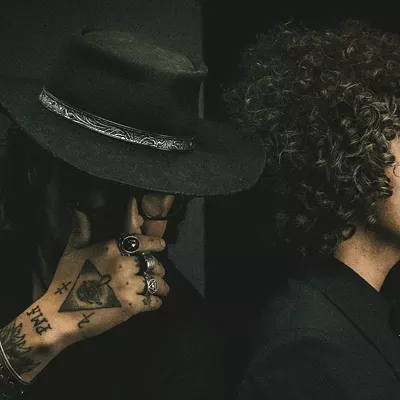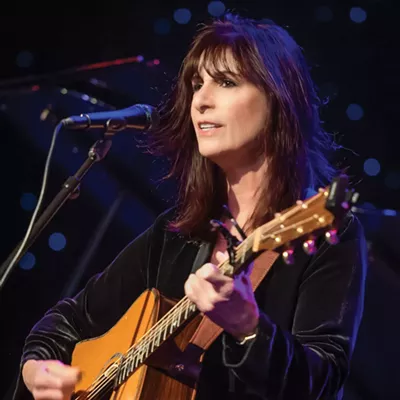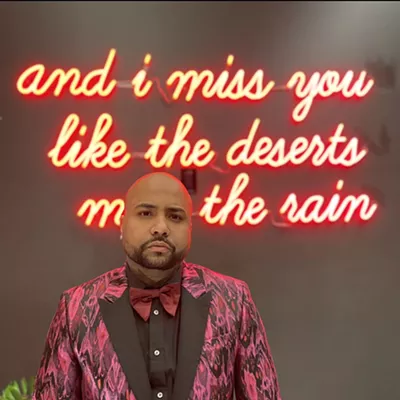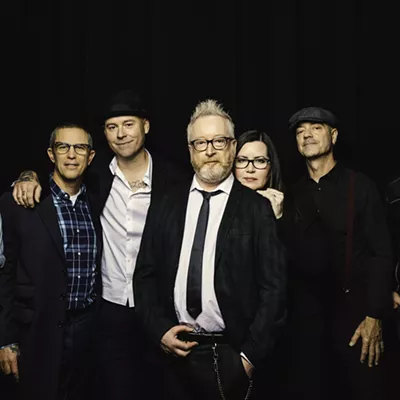There were no boundaries to begin with when ChamberLab set out to present classical music with a punk ethos.
Since its inception in 2010, the core goal for the musically innovative concert series has always been to compose new music for unusual ensembles, performing in strange venues.
So about a year ago when ChamberLab visionary Chris Black got the idea to draw mariachi musicians into the fold (perhaps, he says, hearing the music while dining at Guadalajara Grill), the challenge was set. Instruments at the heart of mariachi, like the vihuela and guitarron, don't exist in classical music, so that fit the paradigm. And Black recruited willing partners in Mariachi Luz de Luna, widely known for collaborating outside the mariachi world with Calexico. The final piece of the puzzle came with Matt Cotton of Puppets Amongus, to give a narrative framework to the project.
"Shadow puppetry works so well with music. It's harmonious in terms of telling a story. The fact that we've eliminated a narrator or any kind of dialogue requires the music to tell the story and it's exciting for me," Cotton says. "We pored over a lot of stories. Some of them are short, some of them are epic. There are certain things about Mexican folk tales that I'm attracted to, especially the magical realism."
Cotton and fellow puppeteer Bradford Trojan will work with two overhead projectors to create the puppet show as the musicians perform. They'll be right in front of the audience, so the concert-goers can see both the mechanics of the process and the resulting projection on the wall above the mariachi band.
"To have the visual element will change the dynamic quite a bit," he says. "It will enrich it with another layer."
Often ChamberLab projects start with no direction, says Marco Rosano, a frequent composer for the series and multi-instrumentalist in Orkesta Mendoza. Having the multiple starting points of the story "El Pajaro Coo," Cotton's imagery and the mariachi sound and style worked to shape and define his composition.
"I just started making musical sketches based on the storyboard, like you would do with a film score. It's nice to work with limitations and other visual elements," Rosano says. "The instrumentation of anything completely changes what I would write. I sat around with a guitar for a month to get an understanding of what's easy for these musicians, what's not so easy."
For Mariachi Luz de Luna, the new project was both a fresh challenge and a musical endeavor that built on the band's past collaborations with Calexico, says John Contreras, guitarist for the group and one of the composers for Leyendas y Sombras.
"I'd heard of ChamberLab in the past and it was always an interesting concept to me. Bringing music to the masses and showing people the different styles that can be incorporated in classical music has always been a cool concept," Contreras says. "When Chris reached out to me I thought this was right up my alley. When he was talking about the composers, down deep inside I thought it would be cool if I could write a piece."
Contreras got his wish, writing music to accompany the story "Horse Hooves and Chicken Feet," the story of a fiesta where things aren't quite as they appear.
"I'd heard the tale in the past, but a little bit differently. That's the funny and cool thing about these folk tales is they get changed a bit as they're passed along," he says. "Getting a chance to work with Matt helped out a lot. Once we saw his storyboards drawn out, I already had melodies and tunes in my head immediately."
ChamberLab's experience in 2014 performing a newly composed, all original soundtrack with an eleven-piece orchestra to accompany Buster Keaton's 1926 silent film The General helped the process of uniting the music with a visual element. But the latest ChamberLab effort brought a whole new degree of difficulty and for the first time, Black had to take on a fundraising role. Leyendas y Sombras is presented with the support of Arizona Friends of Chamber Music, Buffalo Exchange, and Mr. Wesley Green.
"We've normally been like a punk band, splitting the door. To have the support of these particular people, who really care about this music, means we're doing something right," Black says.
The Leyendas y Sombras concert is a uniquely Tucson endeavor, uniting the city's rich mariachi history with eager collaborators, both musicians and visual artists. For ChamberLab, it pushes further than ever on the series' mission to bring artists of different disciplines and backgrounds together in a single performance.
"Chris is a genius. He did a lot of research and homework," Contreras says. "We've heard all these folk tales, but nobody's said 'Let's put them to music and do a presentation with the shadow puppets.' It's a whole new type of performance and it can really hit home."
The project came with its share of challenges. The first couple rehearsals were pretty painstaking, Contreras says, with the mariachi musicians not used to what the outside composers were bringing to them. The compositions were also longer, 12 or 15 minutes, for example, instead of the shorter traditional songs. So in refining the show, larger ambitions were lost to the time crunch and a composition from Dante Rosano was replaced by a medley of traditional mariachi songs that go along with the folk tale.
Still, Leyendas y Sombras features a wide spectrum of collaboration never before attempted in a ChamberLab performance. A new song from a composer outside the mariachi tradition, a new composition from a longtime mariachi performer and a mix of traditional songs recontextualized to fit the shadow puppet storytelling makes the most of everybody's creative efforts.
"We are composers who aren't from this world. We're going in, grabbing performers and bringing them back to our world. That sort of border-hopping is unique," Black says. "This is by far the most ambitious show we've ever done. This is out there. We are in completely unknown territory, in every direction. Everybody has been plucked out of their comfort zone."













